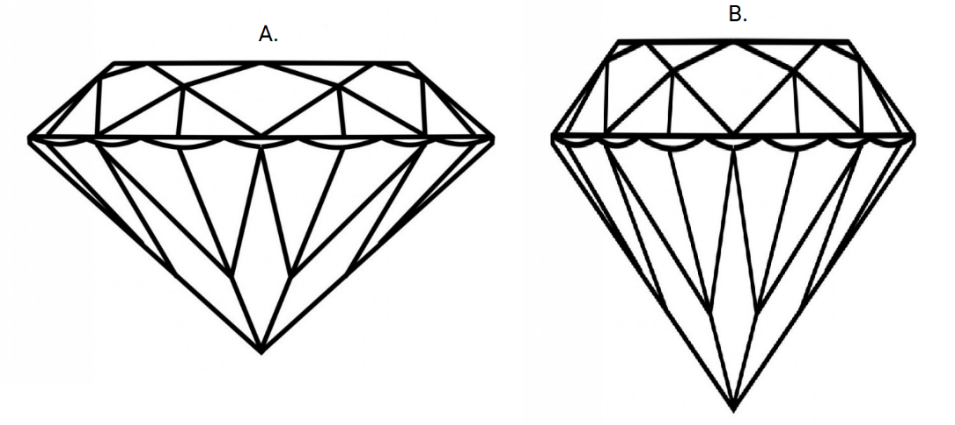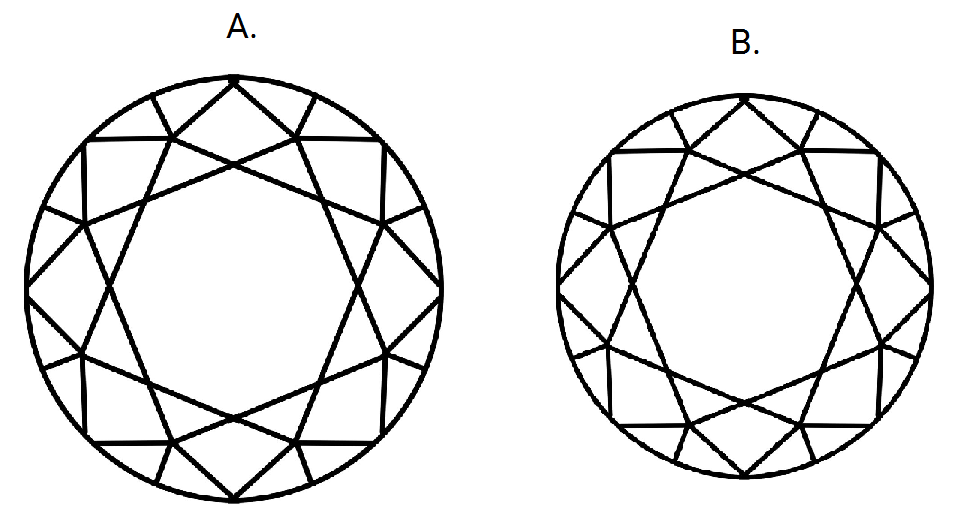January 28th 2022
What To Know About Depth And Table
By Devin Jones
Depth and table percentage can affect how large and how brilliant a diamond appears.
Carat Version 2.0: Depth% and Table%

The diamond on the left (diamond A) is wider while the other diamond (diamond B) is deeper and narrower. Because diamonds are set “face up”, the part of the stone you actually see will look more like the following.

The diamond on the left looks larger, and someone viewing the diamonds in ring settings would assume that stone A was a larger carat size even though both stones are actually the same weight. When more of the stone is hidden from view, the price of the diamond should be lower because the diamond that appears larger is more desired. This is true up to a point.
The image below shows the same stone on the left that we saw before but now compared to a wider, less deep stone (diamond C) with the same exact carat weight. Which diamond would you prefer?
While diamond C clearly has a larger surface area on top, we need to take into account another aspect of diamond optics that we haven’t discussed yet. When light enters the top of a diamond it bounces around inside the stone and shoots back out the top, which our eyes perceive as sparkle or how shiny the diamond is. There are a lot of little angles involved in the refraction and reflection of the light coming out of the stone. If the stone is too deep (diamond B) or too wide (diamond C), then the light will shoot out the top of stone in a less exciting way – it won’t look as sparkly or shiny. So, while diamond C has a larger surface for us to view in the ring setting, it won’t be as visually appealing. Here’s a good depiction from a post on physics.stackexchange.com that shows how light bounces around in a diamond.

Let’s get back to discussing carat weight. Now that you know a little about the way a diamond returns light and the visual size of the top of the stone, we can discuss why carat size matters so much. Since there is a pretty narrow range of acceptable angles and proportions for a diamond to return light properly, getting a large surface area while maintaining a shiny diamond requires a large carat size. But carat size dramatically affects the diamond price, and the affect gets bigger and bigger as the carat size grows. Let’s take a look at two diamonds using the StoneAlgo Price feature to see the difference between a 1 and 2 carat version of the same stone. Here’s the 1 carat version as priced on StoneAlgo.com…
Now, if the pricing were linear (meaning it goes up in a straight line) we would expect the 2 carat version to cost twice as much as the 1 carat diamond. But an interesting thing happens in diamond pricing. Because a 2 carat stone is more than twice as desirable as a 1 carat version, people will pay more than 3 times as much for the second stone in our example. The algorithm calculated these prices using live diamond prices on a particular day in the past so they won’t be exactly the same on StoneAlgo anymore, but the same pattern will hold true and the 2 carat version will be much more expensive than the 1 carat.
This exponential price change makes it tough to figure out how much a diamond should cost, especially when you introduce a minor change, like that between a 1.5 and 1.6 carat stone. Below is a graph of real, live diamond prices from that same historical day we used in the example above. You can see how the diamond price grows faster and faster as the carat size increases. You can also see that the diamond prices are not all on a nice, clear line. In fact, if you look at the prices you can see that as carat size increases, the prices jump around more and more. Some stones appear much more expensive than others of the exact same size, and sometimes smaller stones cost more than larger stones. Remember, all of these stones are of identical quality (based on their GIA grading) except for their carat sizes which are changing on the x-axis at the bottom of the chart (all diamonds here are round, GIA certified, excellent cut, I color, VS2 clarity).
So, a large carat size can get expensive in a hurry. Just look at the difference between a 1 carat, 2 carat, and 3 carat diamond on that chart above. The 3 carat diamond costs around $35,000 while the 1 carat costs about $4,500. That’s a seriously big difference. If you talk to a jeweler or someone who knows diamond pricing inside and out, they’ll likely discuss the idea of price per carat. The price per carat of a 1 carat stone above is about $4,500 but the price per carat of the 3 carat diamond (which costs are $35,000) is closer to $12,000 per carat ($35,000 divided by 3 carats = $11,667 per carat). Price per carat is usually a more useful guide for the appropriate pricing of a stone than the total price because it changes in a more linear fashion.
